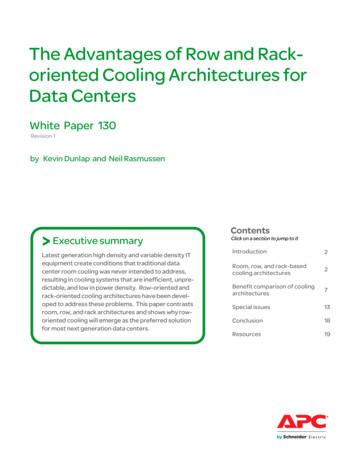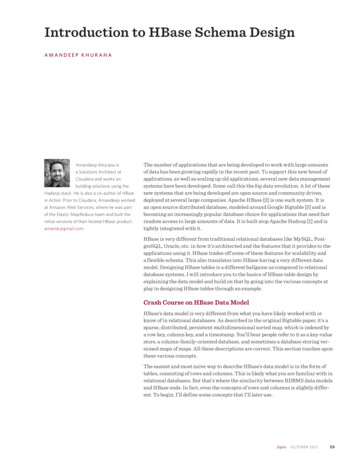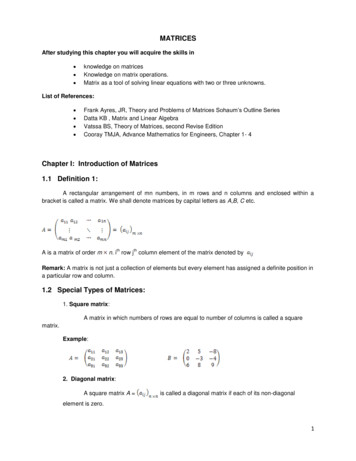
Transcription
The Advantages of Row and Rackoriented Cooling Architectures forData CentersWhite Paper 130Revision 1by Kevin Dunlap and Neil Rasmussen Executive summaryLatest generation high density and variable density ITequipment create conditions that traditional datacenter room cooling was never intended to address,resulting in cooling systems that are inefficient, unpredictable, and low in power density. Row-oriented andrack-oriented cooling architectures have been developed to address these problems. This paper contrastsroom, row, and rack architectures and shows why roworiented cooling will emerge as the preferred solutionfor most next generation data centers.ContentsClick on a section to jump to itIntroduction2Room, row, and rack-basedcooling architectures2Benefit comparison of coolingarchitectures7Special issues13Conclusion18Resources19
The Advantages of Row and Rack-oriented Cooling Architectures for Data CentersIntroductionRelated resourceAPC White Paper 46Cooling Strategies for UltraHigh Density Racks andBlade ServersAll of the electrical power delivered to the IT loads in a data center ends up as waste heatthat must be removed to prevent over temperature conditions. Virtually all IT equipment isair-cooled, that is, each piece of IT equipment takes in ambient air and ejects waste heat intoits exhaust air. Since a data center may contain thousands of IT devices, the result is thatthere are thousands of hot airflow paths within the data center that together represent thetotal waste heat output of the data center; waste heat that must be removed. The purpose ofthe air conditioning system for the data center is to efficiently capture this complex flow ofwaste heat and eject it from the room.Room-based cooling is the historical method for accomplishing data center cooling. In thisapproach, one or more air conditioning systems, working in parallel, push cool air into thedata center while drawing out warmer ambient air. The basic principle of this approach is thatthe air conditioners not only provide raw cooling capacity, but they also serve as a largemixer, constantly stirring and mixing the air in the room to bring it to a homogeneous averagetemperature, preventing hot-spots from occurring. This approach is effective only as long asthe power needed to mix the air is a small fraction of the total data center power consumption. Simulation data and experience show that this system is effective when the averagepower density in data is on the order of 1-2 kW per rack, translating to 323-753 W/m² (30-70W/ft²). Various measures can be taken to increase power density of room based coolingsystems, but there are still practical limits More information on the limitation of usingtraditional room based cooling can be found in APC White Paper 46 “Cooling Strategies forUltra-High Density Racks and Blade Servers ”. Unfortunately, the power densities of modernIT equipment are pushing peak power density to 20 kW per rack or more, where simulationdata and experience show that room-based cooling dependent on air mixing no longerfunctions effectively.To address this problem, new design approaches are emerging that focus on row or rackbased cooling. In these approaches the air conditioning systems are specifically integratedwith rows of racks or individual racks. This provides much better predictability, higherdensity, higher efficiency, and a number of other benefits. In this paper, the various approaches are explained and contrasted. It will be shown that each of the three approacheshas an appropriate application, and in general a trend away from room based cooling towardrow based cooling should be expected for higher density applications.Room, row,and rackbased coolingarchitecturesEvery data center air conditioning system has two key functions: to provide the bulk coolingcapacity, and to distribute the air to the IT loads. The first function of providing bulk coolingcapacity is the same for all cooling architectures, namely, that the bulk cooling capacity of theair conditioning system in kilowatts must exhaust the total power load (kW) of the IT equipment. The various technologies to provide this function are the same whether the coolingsystem is designed at the room, row, or rack level. The major difference between coolingarchitectures lies in how they perform the second critical function, distribution of air to theloads. Unlike power distribution, where flow is constrained to wires and clearly visible as partof the design, airflow is only crudely constrained by the room design and the actual air flow isnot visible in implementation and varies considerably between different installations.Controlling the airflow is the main objective of the different cooling system design approaches.The 3 basic architectures are shown in the generic floor plans depicted in Figure 1. In thefigure, black square boxes represent racks arranged in rows, and the blue arrows representthe logical association of the CRAC units to the loads in the IT racks. The actual physicallayout of the CRAC units may vary. In the room-oriented architecture, the CRAC units areassociated with the room; in the row level architecture the CRAC units are associated withAPC by Schneider ElectricWhite Paper 130 Rev 12
The Advantages of Row and Rack-oriented Cooling Architectures for Data Centersrows or groups, and with the rack level architecture CRAC units are assigned to the individualracks.RoomRowRackFigure 1Floor plans showing the basicconcept of room, row, and rackoriented cooling architecture.Blue arrows indicate the relationof the primary cooling supplypaths to the room.A summary of the basic operating principles of each method are provided in the followingsections:Room-oriented architectureRelated resourceAPC White Paper 55Air Distribution ArchitectureOptions for Mission CriticalFacilitiesIn room-oriented architecture, the CRAC units are associated with the room and operateconcurrently to address the total heat load of the room. A room-oriented architecture mayconsist of one or more air conditioners supplying cool air completely unrestricted by ducts,dampers, vents, etc. or the supply and/or return may be partially constrained by a raised floorsystem or overhead return plenum. For more information see APC White Paper 55, AirDistribution Architecture Options for Mission Critical Facilities.During design, the attention paid to the airflow typically varies greatly. For smaller rooms,racks are sometimes placed in an unplanned arrangement, with no specific planned constraints to the airflow. For larger more sophisticated installations, raised floors may be usedto distribute air into well-planned hot-aisle / cold aisle layouts for the express purpose ofdirecting and aligning the airflow with the IT cabinets.The room-oriented design is heavily affected by the unique constraints of the room, includingthe ceiling height, the room shape, obstructions above and under the floor, rack layout,CRAC location, the distribution of power among the IT loads, etc. The result is that performance prediction and performance uniformity are poor, particularly as power density isincreased. Therefore, complex computer simulations called computational fluid dynamics(CFD) may be required to help understand the design performance of specific installations.Furthermore, alterations such as IT equipment moves, ads, and changes may invalidate theperformance model and require further analysis and/or testing. In particular, the assurance ofCRAC redundancy becomes a very complicated analysis that is difficult to validate.Another significant shortcoming of room-oriented architecture is that in many cases the fullrated capacity of the CRAC cannot be utilized. This condition is a result of room design andoccurs when a significant fraction of the air distribution pathways from the CRAC unitsbypass the IT loads and return directly to the CRAC. This bypass air represents CRACairflow that is not assisting with cooling of the loads; in essence a decrease in overall coolingAPC by Schneider ElectricWhite Paper 130 Rev 13
The Advantages of Row and Rack-oriented Cooling Architectures for Data CentersRelated resourceAPC White Paper 49Avoidable Mistakes thatCompromise CoolingPerformance in DataCenters and Network Roomscapacity. The result is that cooling requirements of the IT layout can exceed the coolingcapacity of the CRAC even when additional bulk cooling (kW) capacity of the CRAC is notfully utilized. This problem is discussed in more detail in APC White Paper 49, AvoidableMistakes that Compromise Cooling Performance in Data Centers and Network Rooms.Row-oriented architectureWith a row-oriented architecture, the CRAC units are associated with a row and are assumedto be dedicated to a row for design purposes. The CRAC units may be mounted among theIT racks, they may be mounted overhead, or they may be mounted under the floor. Compared with the room-oriented architecture, the airflow paths are shorter and more clearlydefined. In addition, airflows are much more predictable, all of the rated capacity of theCRAC can be utilized, and higher power density can be achieved.The row-oriented architecture has a number of side benefits other than cooling performance.The reduction in the airflow path length reduces the CRAC fan power required, increasingefficiency. This is not a minor benefit, when we consider that in many lightly loaded datacenters the CRAC fan power losses alone exceed the total IT load power consumption.A row-oriented design allows cooling capacity and redundancy to be targeted to the actualneeds of specific rows. For example, row-oriented architecture allows one row of racks to runhigh density applications such as blade server, while another row satisfies lower powerdensity applications such as communication enclosures. Furthermore, N 1 or 2N redundancy can be targeted at specific rows.A row-oriented architecture can be implemented without a raised floor. This increases thefloor load bearing capacity, reduces installation costs, eliminates the need for access ramps,and allows data centers to exist in buildings that otherwise do not have the headroom topermit the installation of a sufficient raised floor. This is particularly an issue for high densityinstallations where a raised floor height of one meter or more is required. Examples of roworiented cooling products are shown in Figures 2a and 2b.Figure 22a (left)Row floor mounted cooling2b (right)Row overhead coolingRelated resourceAPC White Paper 135Hot vs Cold AisleContainmentBoth the row floor mounted and overhead systems in Figure 2a and 2b can also be configured as a hot-aisle containment system that extends the power density capability. Thisdesign further increases the performance predictability by eliminating any chance of airmixing. Room cooling systems are also starting to leverage the use of containment toincrease power densities. Both hot and cold aisle containment are being used to minimizemixing in data centers. Each of these solutions has its own unique advantages that aredescribed in further detail in APC White Paper 135, Hot vs Cold Aisle Containment.APC by Schneider ElectricWhite Paper 130 Rev 14
The Advantages of Row and Rack-oriented Cooling Architectures for Data CentersRelated resourceAPC White Paper 120Guidelines for Specificationof Data Center PowerDensityThe simple and pre-defined layout geometries of row-oriented architecture give rise topredictable performance that can be completely characterized by the manufacturer and arerelatively immune to the affects of room geometry or other room constraints. This simplifiesboth the specification and the implementation of designs, particularly at densities over 5 kWper rack. The specification of power density is defined in detail in APC White Paper 120,Guidelines for Specification of Data Center Power Density.While it appears that this architecture automatically requires more CRAC units than a roomoriented architecture, this is not necessarily true, particularly at higher power density. Thiswill be described later.Rack-oriented architectureIn rack-oriented architecture, the CRAC units are associated with a rack and are assumed tobe dedicated to a rack for design purposes. The CRAC units are directly mounted to or withinthe IT racks. Compared with the room-oriented or row-oriented architecture, the rackoriented airflow paths are even shorter and exactly defined, so that airflows are totallyimmune to any installation variation or room constraints. All of the rated capacity of theCRAC can be utilized, and the highest power density (up to 50 kW per rack) can be achieved.An example of a rack-oriented cooling product is shown in Figure 3.Similar to row cooling, the rack-oriented architecture has other unique characteristics inaddition to extreme density capability. The reduction in the airflow path length reduces theCRAC fan power required, increasing efficiency. As mentioned above, this is not a minorbenefit considering that in many lightly loaded data centers the CRAC fan power losses aloneexceed the total IT load power consumption.A rack-oriented design allows cooling capacity and redundancy to be targeted to the actualneeds of specific racks, for example, different power densities for blade servers vs. communication enclosures. Furthermore, N 1 or 2N redundancy can be targeted to specific racks.By contrast, row-oriented architecture only allows these characteristics to be specified at therow level, and room-oriented architecture only allows these characteristics to be specified atthe room level.Figure 3Rack cooling solution withcooling completely internalto rackAPC by Schneider ElectricWhite Paper 130 Rev 15
The Advantages of Row and Rack-oriented Cooling Architectures for Data CentersRelated resourceAPC White Paper 120Guidelines for Specificationof Data Center PowerDensityThe deterministic geometry of rack-oriented architecture gives rise to predictable performance that can be completely characterized by the manufacturer and are totally immune to theaffects of room geometry or other room constraints. This allows simple specification of powerdensity and design to implement the specified density. The specification of power density isdefined in detail in APC White Paper 120, Guidelines for Specification of Data Center PowerDensity.The principal drawback of this approach is that it requires a large number of air conditioningdevices and associated piping when compared to the other approaches, particularly at lowerpower density. This will be quantified later in this paper.Hybrid architectureNothing prevents the room, row, and rack architectures from being used together in the sameinstallation. In fact, there are many cases where mixed use is beneficial. Using variouscooling architectures in the same data center is considered a hybrid approach. This approach is beneficial to data centers operating with a broad spectrum of rack power densitiesdue to the mix of all three architecture types as shown in Figure 4:Figure 4Floor layout of a systemutilizing room, row, and rackoriented tedRoom-orientedx Room-oriented: Supplying a room but primarily serving a low density area of mixedequipment such as communication equipment, low density servers, and storage. Target: 1-3 kW per rack, 323-861 W/m² (30-80 W/ft²)x Row-oriented: Supplying a high density or ultra-high density area with blade servers or1U servers.x Rack-oriented: Supplying isolated high density racks, or ultra-high density racks.Another effective use of row and rack-oriented architecture is for density upgrades within anexisting low density room-oriented design. In this case, small groups of racks within anexisting data center are outfitted with row or rack-oriented cooling systems. The row or rackcooling equipment effectively isolates the new high density racks, making them essentially “thermally neutral ” to the existing room-oriented cooling system. In this way, high densityloads can be added to an existing low density data center without modifying the existingAPC by Schneider ElectricWhite Paper 130 Rev 16
The Advantages of Row and Rack-oriented Cooling Architectures for Data Centersroom-oriented cooling system. When deployed, this approach results in the same hybridarchitecture depicted by Figure 4 above.Another example of a hybrid approach is the use of a ducted exhaust rack cooling system tocapture exhaust air at the rack level and duct it directly back to a room-oriented coolingsystem. This system has some of the benefits of a rack-oriented cooling system but canintegrate into an existing or planned room-oriented cooling system. An example of thisequipment is shown in Figure 5.Figure 5Rack level ducted exhaustinto dropdown ceilingBenefitcomparison ofcoolingarchitecturesTo make effective decisions regarding choice of architecture for new data centers or upgrades, it is essential to relate the performance characteristics of the architectures topractical issues that affect the design and operation of real data centers. A survey of datacenter operators suggests that these issues can be categorized into one of the following:x Agilityx System availabilityx Lifecycle costs (TCO)x Serviceabilityx ManageabilityIn this section, we review each of the above categories that users have identified, and focuson how the alternative architectures address key cooling challenges. The highest prioritychallenges are listed first under each category, and were determined by number of mentionscombined priority expressed by the respondents.APC by Schneider ElectricWhite Paper 130 Rev 17
The Advantages of Row and Rack-oriented Cooling Architectures for Data CentersAgility challengesData center users have identified the agility challenges shown in Table 1 as critical coolingrelated issues. The effectiveness of the different architectures in addressing these challenges is summarized as well.Table 1Effectiveness of the room, row, and rack-oriented coolingarchitectures in addressing agility challenges. Bestperformance highlighted.Agility challengesChallengeRackRowRoomPlan for a powerdensity that isincreasing andunpredictableModular; deployable atrack level incrementstargeted at specificdensityModular; deployable atrow level incrementstargeted at specificdensityComplex to upgrade oradapt; typically built out inadvance of requirementReduce the extensiveengineering requiredfor custominstallationsImmune to room effects;rack layout may becompletely arbitraryImmune to room effectswhen rows laid outaccording to standarddesigns; configure withsimple toolsComplex CFD analysisrequired which is differentfor every roomAdapt to everchangingrequirements or anypower densityRack cooling capacity thatis not used cannot beused by other racksCooling capacity is welldefined and can beshared across a group ofracksAny change may result inoverheating; complexanalysis required to assureredundancy and density areachievedAllow for coolingcapacity to be addedto an existingoperating spaceNew loads may be addedthat are completelyisolated from the existingcooling system; limited torack cooling capacityNew loads may beadded that are completely isolated from theexisting cooling system;each additional coolingsystem increasesdensity for entire rowMay require shutdown ofexisting cooling system;requires extensive engineeringProvide a highlyflexible coolingdeployment withminimalreconfigurationRacks may need to beretrofit or IT equipmentmoved to accommodatenew architectureRequires the rack rowsto be spaced to accommodate or changes tooverhead infrastructurefor new architectureFloor tiles can be reconfigured quickly to changecooling distribution patternfor power densities 3 kWAPC by Schneider ElectricWhite Paper 130 Rev 18
The Advantages of Row and Rack-oriented Cooling Architectures for Data CentersAvailability challengesData center users have identified the availability challenges shown in Table 2 as criticalcooling-related issues. The effectiveness of the different architectures in addressing thesechallenges is summarized as well.Table 2Effectiveness of the room, row, and rack-oriented coolingarchitectures in addressing availability challenges. Bestperformance highlighted.Availability challengesChallengeRackRowRoomEliminate hot spotsClosely couples heatremoval with the heatgeneration to eliminatemixingThe airflow is completely contained in therackClosely couplesheat removal with theheat generation tominimize mixingSupply and return pathspromote mixing; engineered ductwork requiredto separate air streamsAssure redundancywhen required2N cooling capacityrequired for each rack;many rack coolingsystems are not redundant capableUtilizes shared N 1capacity across common air returnComplex CFD analysisrequired to model failuremodes; requires localizedredundancyHeat captured at therear of the rack beforemixing with cold supplyairWarm air may recirculate tofront of rack as a result ofinsufficient heat removal orsupplyMinimize the possibility of liquid leaks in themission critical installationOperates at warmerreturn temperatures toreduce or eliminatemoisture removal andmake-up sources. Racktargeted cooling requiresadditional piping andleakage pointsOperates at warmerreturn temperatures toreduce or eliminatemoisture removal andmake-up sourcesMixed air return promotesthe production of condensate and increases requirement for humidificationMinimize human errorStandardized solutionsare well documented andcan be operated by anyuserStandardized solutionsare well documentedand can be operated byany userUniquely engineeredsystem requires a highlytrained and specializedoperatorEliminate verticaltemperaturegradients at the faceof the rackHeat captured at the rearof the rack before mixingwith cold supply airAPC by Schneider ElectricWhite Paper 130 Rev 19
The Advantages of Row and Rack-oriented Cooling Architectures for Data CentersLifecycles cost challengesData center users have identified the lifecycle cost challenges shown in Table 3 as highpriority cooling-related issues. The effectiveness of the different architectures in addressingthese challenges is summarized as well.Table 3Effectiveness of the room, row, and rack-oriented coolingarchitectures in addressing lifecycle cost challenges. Bestperformance highlighted.Lifecycle cost challengesChallengeRackRowRoomOptimize capitalinvestment andavailable spaceDedicated system foreach rack may result inoversizing and wastedcapacityAbility to match thecooling requirements toa much higher percentage of installed capacitySystem performance isdifficult to predict, resultingin frequent oversizingAccelerate speed ofdeploymentPre-engineered systemthat eliminates or reduces planning andengineeringPre-engineered systemthat eliminates orreduces planning andengineeringRequires unique engineering that may exceed theorganizational demandLower the cost ofservice contractsStandardized components reduce service timeand facilitate the abilityfor user serviceability.Likely higher number ofunits with 1:1 ratio to ITracks enclosures.Standardized components reduce servicetime and facilitates theability for user serviceabilitySpecialized service contracts required for customcomponentsQuantify the return oninvestment for coolingsystem improvementsStandardized components for accuratemeasurement of systemperformanceStandardized components for accuratemeasurement of systemperformanceCustomer engineeredsolutions makes systemperformance difficult topredictCooling system will likelybe oversized and fullpotential not realized.Right-sized coolingcapacity to the coolingload matching heat loadto installed capacityAir delivery dictatesoversized capacity; pressure requirements forunder floor delivery are afunction of the room sizeand floor depth.Maximize theoperational efficiencyby matching capacityto loadAPC by Schneider ElectricWhite Paper 130 Rev 110
The Advantages of Row and Rack-oriented Cooling Architectures for Data CentersServiceability challengesData center users have identified the serviceability challenges shown in Table 4 as highpriority cooling-related issues. The effectiveness of the different architectures in addressingthese challenges is summarized as well.Table 4Effectiveness of the room, row, and rack-oriented coolingarchitectures in addressing serviceability challenges. Bestperformance highlighted.Serviceability challengesChallengeRackRowRoomDecrease Mean-TimeTo-Recover(includes repair timeplus technician arrival,diagnosis, and partsarrival times)Modular componentsreduces downtime; 2Nredundancy required forsystem repair andmaintenanceModular componentsreduces downtime; N 1or excess capacityallows for repair withoutinterruption to systemperformanceCustom spare parts are notreadily available andrequire trained technicianextending recovery timeSimplify the complexityof the systemStandardized components reduce the technical expertise required forroutine service andmaintenanceStandardized components reduce thetechnical expertiserequired for routineservice and maintenanceOperation and repair of thesystem requires trainedexperts.Simpler serviceproceduresIn-house staff canperform routine serviceprocedures.Modular subsystems withinterfaces that mistakeproof service procedures.In-house staff canperform routine serviceprocedures.Modular subsystemswith interfaces thatmistake-proof serviceprocedures.Routine service proceduresrequire disassembly ofunrelated subsystems.Some service items are noteasy to access when thesystem is installed. Highlyexperienced personnel arerequired for many serviceprocedures.Minimize vendorinterfacesModular units designed tointegrate with a small setof ancillary systemsModular units designedto integrate with a smallset of ancillary systemsEngineered solution withmulti-vendor subsystemsLearn from pastproblems and sharelearning acrosssystemsStandardized buildingblock approach withsingle rack and coolingunit interaction maximizes learningStandardized buildingblock approach with lowinteractions increaseslearning but with fewersystems to learn fromUnique floor layouts all haveunique problems, limitinglearningAPC by Schneider ElectricWhite Paper 130 Rev 111
The Advantages of Row and Rack-oriented Cooling Architectures for Data CentersManageability challengesData center users have identified the manageability challenges shown in Table 5 asimportant cooling-related issues. The effectiveness of the different architectures in addressing these challenges is summarized as well.Table 5Effectiveness of the room, row, and rack-oriented coolingarchitectures in addressing manageability challenges.Best performance highlighted.Manageability challengesChallengeSystem menu must beclear and provide easeof navigationProvide predictivefailure analysisProvide, aggregate,and summarize coolingperformance dataRackRowRoomLow option configurationallows user to navigatethrough menu interfacequicklyLow option configuration allows user tonavigate through menuinterface quicklyHighly configurable systemcomplicates the menustructure. Requires advanced service trainingAbility to provide realtime models of currentand future performance.Ability to provide nearreal-time models ofcurrent or futureperformance as a resultof limited controleffectsVirtually impossible toprovide real-time models ofcurrent or future performance due to room-specificeffectsCooling capacity information at the rack level isdetermined and availablein real timeCooling capacityinformation at the rowlevel is determined andavailable in real time.Rack level informationcan be effectivelyestimated.Cooling capacity information is not available at therack or row levelSummary and analysisA review and analysis of the above comparison tables suggests the following conclusions:x The modular rack-oriented architecture is the most flexible, fast to implement, andachieves extreme density, but at the cost of additional expense.x Room-oriented architecture is inflexible, time consuming to implement, and performspoorly at higher density but has cost and simplicity advantages at lower density.x The modular row-oriented architecture provides many of the flexibility, speed, anddensity advantages of the rack-oriented approach, but with a cost similar to the roomoriented architecture.These issues are explained in additional detail in the following sections.APC by Schneider ElectricWhite Paper 130 Rev 112
The Advantages of Row and Rack-oriented Cooling Architectures for Data CentersSpecial issuesThere are a number of practical issues that require additional explanation and discussionregarding the architectures. These are discussed in this section.Capacity utilizationFigure 6Usable air conditioner capacity asa function of average rack powerdensity for the three coolingarchitectureUsable CRAC CapacityMost users naturally assume that if they have 500 kW of cooling units installed, they caninstall and cool 500 kW of IT loads. This is simply not the case. While a group of airconditioning units taken together may have in total the claimed capacity, this does not meanthat they are able to deliver this cooling to the load. The fraction of the actual capacity thatcan be obtained in the real world cooling IT loads is called the “usable capacity ”. Any timethe usable capacity is less than 100%, the CRAC systems must be oversized with theattendant increases in cost, space, and maintenance. The three cooling system architectureshave dramatically different behavior in this regard, as explained in the following sections andsummarized in Figure 6.100%80%row-oriented cooling60%room-oriented cooling40%20%rack-oriented cooling0%1 2 3 4 5 6 7 8 9 10 11 12 13 14 15 16 17 18 19 20 21 22 23 24 25Average Per-Rack Power Density (kW)The figure shows how the usable capacity varies for the three different cooling architecturesas a function of rack power density. This model assumed a peak-to-average rack powerdensity of 1.5:1, an N 1 cooling redundancy requirement, a maximum row length of 10 racks,a room CRA
Every data center air conditioning system has two key functions: to provide the bulk cooling capacity, and to distribute the air to the IT loads. . Performance in Data Centers and Network Rooms APC White Paper 49 Figure 2 Row-oriented architecture With a row-oriented architecture, the CRAC units are associated with a row and are assumed










